英语,教学,情境分析题
2018上半年教师资格证考试真题答案解析:高中英语
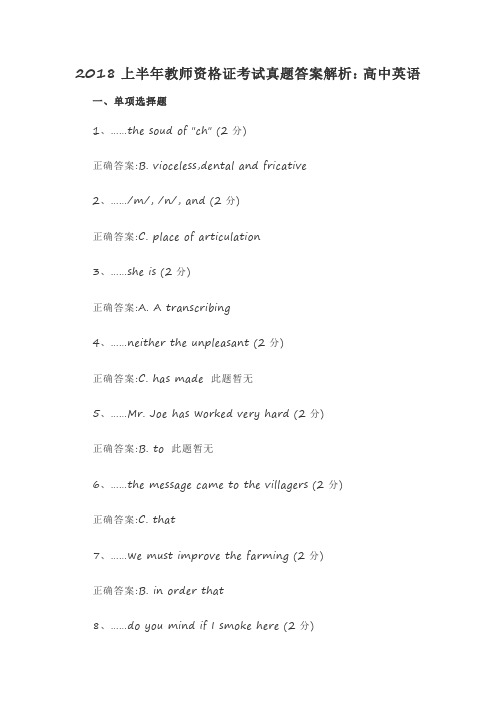
2018上半年教师资格证考试真题答案解析:高中英语一、单项选择题1、……the soud of "ch" (2分)正确答案:B. vioceless,dental and fricative2、……/m/, /n/, and (2分)正确答案:C. place of articulation3、……she is (2分)正确答案:A. A transcribing4、……neither the unpleasant (2分)正确答案:C. has made 此题暂无5、……Mr. Joe has worked very hard (2分)正确答案:B. to 此题暂无6、……the message came to the villagers (2分)正确答案:C. that7、……we must improve the farming (2分)正确答案:B. in order that8、……do you mind if I smoke here (2分)正确答案:C. No, not at all9、……what is the main rhetoric cevice u sed in (2分)正确答案:D. Transferred epithet10、……A:let us go to movie (2分)正确答案:A. Illocutionary act11、……which of the following activity is NOT (2分)正确答案:D. pattern practice12、……if a teacher shows students (2分)正确答案:B. demonstration13、……when a teacher asks to (2分)正确答案:B. analyze the structure of the passage14、……which of the following practices can encourage (2分)正确答案:C. finding detailed information15、……which of the following is a dispaly (2分)正确答案:D. What happened to the girl at the end of the story16、……which of the following would a teacher encourage (2分)正确答案:B. to summarize a story17、……which of the following exercises would a teacher most (2分)正确答案:A. paraphrasing sentence18、……the advantages of pair and group (2分)正确答案:D. opportunities to guarantee accuracy19、……which of the following should a teacher avoid (2分)正确答案:B. Teaching words in context and giving examples.20、……which of the following practices is most likely to (2分)正确答案:A. Doing a project21、……what has made students spread along an achievem ent (2分)正确答案:C. The early prerequisites student mastered.22、……what is the author's attitude (2分)正确答案:C. Negative.23、……which of the following is closed in (2分)正确答案:D. Dropped sharply.24、……which of the following ……of the schools (2分)正确答案:D. Students’p erception and the reality of their performance on assessments.25、……which of the following will be ……according to the (2分)正确答案:A. Students’learning effort.26、……what does Kathleen Wermke's (2分)正确答案:B. Baby’s cries could be their early language acquisition.27、……"ambient" in paragraph 2 (2分)正确答案:A. surrounding28、……why do German and French babies (2分)正确答案:D. Because they can somehow control their sound production29、……when does language (2分)正确答案:B. It begins before the birth of a baby30、……what can be i nferred from (2分)正确答案:C.Studying babies’ cries helps us understand their speech perception二、简答题31、……mind mapping 含义(2分)用途(6分),三点注意事项(6分),用法(4分)正确答案:(1)思维导图是运用图文并重的技巧,把各级主题关系用相互隶属与相关的层级图表现出来。
高中英语情境教学现存问题及成因分析
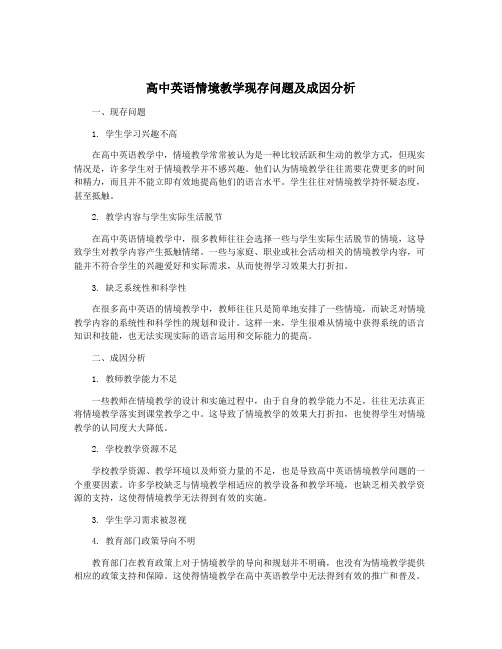
高中英语情境教学现存问题及成因分析一、现存问题1. 学生学习兴趣不高在高中英语教学中,情境教学常常被认为是一种比较活跃和生动的教学方式,但现实情况是,许多学生对于情境教学并不感兴趣。
他们认为情境教学往往需要花费更多的时间和精力,而且并不能立即有效地提高他们的语言水平。
学生往往对情境教学持怀疑态度,甚至抵触。
2. 教学内容与学生实际生活脱节在高中英语情境教学中,很多教师往往会选择一些与学生实际生活脱节的情境,这导致学生对教学内容产生抵触情绪。
一些与家庭、职业或社会活动相关的情境教学内容,可能并不符合学生的兴趣爱好和实际需求,从而使得学习效果大打折扣。
3. 缺乏系统性和科学性在很多高中英语的情境教学中,教师往往只是简单地安排了一些情境,而缺乏对情境教学内容的系统性和科学性的规划和设计。
这样一来,学生很难从情境中获得系统的语言知识和技能,也无法实现实际的语言运用和交际能力的提高。
二、成因分析1. 教师教学能力不足一些教师在情境教学的设计和实施过程中,由于自身的教学能力不足,往往无法真正将情境教学落实到课堂教学之中。
这导致了情境教学的效果大打折扣,也使得学生对情境教学的认同度大大降低。
2. 学校教学资源不足学校教学资源、教学环境以及师资力量的不足,也是导致高中英语情境教学问题的一个重要因素。
许多学校缺乏与情境教学相适应的教学设备和教学环境,也缺乏相关教学资源的支持,这使得情境教学无法得到有效的实施。
3. 学生学习需求被忽视4. 教育部门政策导向不明教育部门在教育政策上对于情境教学的导向和规划并不明确,也没有为情境教学提供相应的政策支持和保障。
这使得情境教学在高中英语教学中无法得到有效的推广和普及。
三、改进对策为了解决高中英语情境教学现存的问题,我们可以采取以下改进对策:学校应该加强对教师的培训和指导,帮助他们提升自身的情境教学能力,从而更好地将情境教学运用到实际的课堂教学中,提高教学效果。
学校应该加大对教学资源和教学环境的投入,尽可能地提供与情境教学相适应的教学设备和教学环境,从而为情境教学提供更好的保障。
高中英语教案模板学情分析

一、学情分析1. 学生背景本单元针对的是高中一年级学生,他们刚刚步入高中生活,对英语学习充满好奇和热情。
然而,由于初中阶段英语学习的基础参差不齐,部分学生在语法、词汇、阅读和写作等方面存在一定困难。
2. 学生特点(1)学习兴趣较高,但缺乏系统学习方法。
学生普遍对英语学习感兴趣,但缺乏科学的学习方法和策略。
(2)英语基础薄弱。
部分学生在初中阶段英语学习过程中,由于种种原因导致英语基础薄弱,难以跟上高中英语教学进度。
(3)学习态度不端正。
部分学生对英语学习缺乏信心,遇到困难时容易放弃。
3. 教学难点(1)词汇积累。
本单元涉及较多与健康生活相关的词汇,学生需要掌握并运用。
(2)语法知识。
本单元涉及一般现在时和现在进行时,学生需要正确运用。
(3)阅读理解。
本单元阅读材料较长,学生需要抓住文章主旨,理解文章细节。
(4)写作能力。
本单元要求学生撰写一篇关于健康生活的短文,学生需要具备一定的写作技巧。
二、教学目标1. 知识目标(1)掌握本单元的词汇和语法知识。
(2)提高阅读理解能力。
(3)提高写作能力。
2. 能力目标(1)培养学生自主学习、合作学习的能力。
(2)提高学生运用英语进行交流的能力。
3. 情感目标(1)激发学生学习英语的兴趣。
(2)培养学生关爱健康、关注生活的意识。
三、教学重难点1. 教学重点(1)词汇和语法知识的掌握。
(2)阅读理解和写作能力的提高。
2. 教学难点(1)词汇的积累和应用。
(2)语法知识的灵活运用。
(3)阅读理解中的细节把握。
(4)写作技巧的掌握。
四、教学方法1. 任务型教学法:通过设计贴近学生生活的任务,让学生在完成任务的过程中学习英语。
2. 合作学习法:通过小组合作,培养学生的团队协作能力。
3. 情境教学法:创设真实情境,提高学生的英语实际应用能力。
4. 互动式教学法:通过师生互动、生生互动,激发学生的学习兴趣。
五、教学过程1. 导入(1)展示健康生活的图片,引导学生思考健康的重要性。
中学教师资格认定考试(初级英语学科知识与教学能力)模拟试卷47(
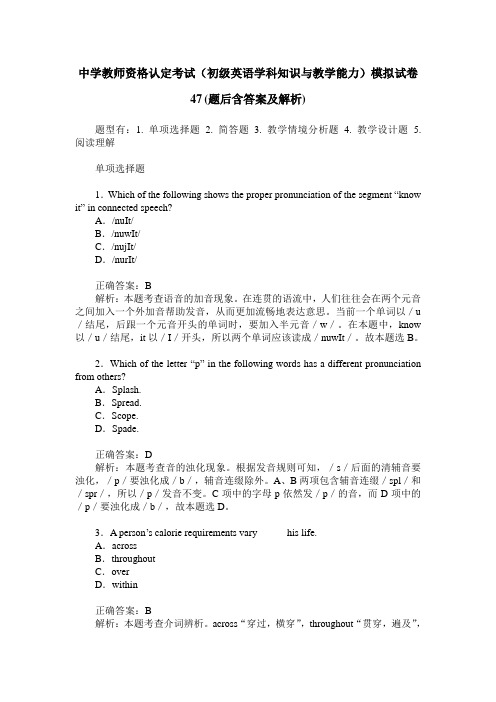
中学教师资格认定考试(初级英语学科知识与教学能力)模拟试卷47(题后含答案及解析)题型有:1. 单项选择题 2. 简答题 3. 教学情境分析题 4. 教学设计题 5. 阅读理解单项选择题1.Which of the following shows the proper pronunciation of the segment “know it” in connected speech?A./nuIt/B./nuwIt/C./nujIt/D./nurIt/正确答案:B解析:本题考查语音的加音现象。
在连贯的语流中,人们往往会在两个元音之间加入一个外加音帮助发音,从而更加流畅地表达意思。
当前一个单词以/u /结尾,后跟一个元音开头的单词时,要加入半元音/w/。
在本题中,know 以/u/结尾,it以/I/开头,所以两个单词应该读成/nuwIt/。
故本题选B。
2.Which of the letter “p” in the following words has a different pronunciation from others?A.Splash.B.Spread.C.Scope.D.Spade.正确答案:D解析:本题考查音的浊化现象。
根据发音规则可知,/s/后面的清辅音要浊化,/p/要浊化成/b/,辅音连缀除外。
A、B两项包含辅音连缀/spl/和/spr/,所以/p/发音不变。
C项中的字母p依然发/p/的音,而D项中的/p/要浊化成/b/,故本题选D。
3.A person’s calorie requirements vary______his life.A.acrossB.throughoutC.overD.within正确答案:B解析:本题考查介词辨析。
across“穿过,横穿”,throughout“贯穿,遍及”,over“在……的上方,越过”,within“在……之内,在……里面”。
句意为“人一生中对卡路里的需求是不同的”。
(A)教师资格认定考试高级中学英语-7_真题-无答案
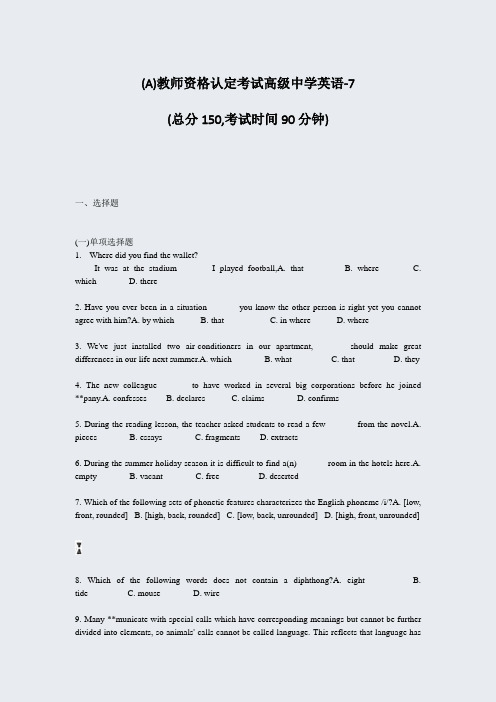
(A)教师资格认定考试高级中学英语-7(总分150,考试时间90分钟)一、选择题(一)单项选择题1. --Where did you find the wallet?--It was at the stadium ______ I played football,A. that B. where C. which D. there2. Have you ever been in a situation ______ you know the other person is right yet you cannot agree with him?A. by which B. that C. in where D. where3. We've just installed two air-conditioners in our apartment, ______ should make great differences in our life next summer.A. which B. what C. that D. they4. The new colleague ______ to have worked in several big corporations before he joined **pany.A. confesses B. declares C. claims D. confirms5. During the reading lesson, the teacher asked students to read a few ______ from the novel.A. pieces B. essays C. fragments D. extracts6. During the summer holiday season it is difficult to find a(n) ______ room in the hotels here.A. empty B. vacant C. free D. deserted7. Which of the following sets of phonetic features characterizes the English phoneme /i/?A. [low, front, rounded] B. [high, back, rounded] C. [low, back, unrounded] D. [high, front, unrounded]8. Which of the following words does not contain a diphthong?A. eight B. tide C. mouse D. wire9. Many **municate with special calls which have corresponding meanings but cannot be further divided into elements, so animals' calls cannot be called language. This reflects that language hasthe feature of ______.A. duality B. arbitrariness C. creativity D. displacement10. A: It's slippy. B: Bless you. A: Thank you. This example explains that language has ______ function.A. informative B. performative C. phatic D. emotive11. The emblem of the Democratic Party is ______.A. elephant B. donkey C. bear D. bull12. The test that attempts to measure students' natural abilities to learn a foreign language is called ______.A. aptitude test B. proficiency test C. achievement test D. diagnostic test13. Which of the following is a communication game?A. bingo B. word chain C. role-play D. cross-word puzzle14. Which of the following can help train speaking?A. listening and following instructions B. Simon says C. pairs finding D. matching captions with pictures15. In writing, which session is used to get students to think freely and put down all possible ideas related to the topic **e to their minds?A. proofreading B. revising C. brainstorming D. mapping16. What's the teacher doing by saying "Who wants to have a try? "?A. controlling discipline B. giving prompt C. evaluating students' work D. directing students' attention to the lesson17. Which of the following activities is the most suitable for group work?A. guessing game B. story telling C. information-gap D. drama performance18. What do the following sentences practice?Peter and I went to the cinema yesterday.Peter and I went to the cinema yesterday.Peter and I went to the cinema yesterday.Peter and I went to the cinema yesterday.A. stress B. articulation C. liaison D. intonation19. What learning strategy can the following help to train?"Match the adjectives on the left with the nouns on the right."A. grouping B. collocation C. imitation D. imagery20. Which of the following is true about second language learning?A. natural language exposure B. informal learning context C. structured input D. little error correction(二)阅读理解题When we analyze the salt salinity(盐浓度)of ocean waters, we find that it varies only slightly from place to place. Nevertheless, some of these small changes are important. There are three basic processes that cause a change in oceanic salinity. One of these is the subtraction of water from the ocean by means of evaporation. In this manner, the salinity is increased, since the salt stays behind. If this is carried to the extreme, of course, white salt would be left behind; this, by the way, is how much of the table salt we use is actually obtained.The opposite of evaporation is precipitation, such as rain, by which water is added to the ocean. Here the ocean is being diluted so that the salinity is decreased. This may occur in areas of high rainfall or in coastal regions where rivers flow into the ocean. Thus salinity may be increased by the subtraction of water by evaporation, or decreased by the addition of fresh water by precipitation.Normally, in hot regions where the sun is very strong, the ocean salinity is somewhat higher than it is in other parts of the world where there is not as much evaporation. Similarly, in coastal regions where rivers dilute the sea, salinity is somewhat lower than in other oceanic areas.A third process by which salinity may be altered is associated with the formation and melting of sea ice. When seawater is frozen, the dissolved materials are left behind. In this manner, sea- water directly beneath freshly formed sea ice has a higher salinity than it did before the ice appeared. Of course, when this ice melts, it will tend to decrease the salinity of the surrounding water.In the Weddell Sea, the densest water in the ocean is formed as a result of this freezing process, which increases the salinity of cold water. This heavy water sinks and is found in the deeper portion of the oceans of the world.1. This passage mainly tells us about ______.A. the analysis of the salinity of ocean waters B. the causes of the variation in oceanic salinity C. the importance of the changes in oceanic salinity D. the different forms of salts in ocean waters2. It can be known from the passage that increase in the salinity of ocean water is caused by ______.A. melting of sea ice B. precipitation C. evaporation D. supplement of salt3. Which of the following is not the cause of the decrease in the oceanic salinity?A. Precipitation. B. Rain and snow. C. Formation of ice. D. Addition of water by rivers.4. Which of the following statements is TRUE according to the passage?A. Oceanic salinity has great effect on sea life. B. Many **bine to cause changes in oceanic salinity. C. The movement of the water is related to the amount of salt. D. The temperature of the water has much to do with the oceanic salinity.5. The purpose of mentioning the Weddell Sea is ______.A. to give an example of cold-water salinity B. to point out the location of deep waters C. to make a comparison between hot-water salinity and cold-water salinity D. to show that the water in the Weddell Sea varies in salinity from place to placeWhen my family moved to America in 2010 from a small village in Guangdong, China, we brought not only our luggage, but also our village rules, customs and culture. One of the rules is that young people should always respect elders. Unluckily, this rule led to my very first embarrassment in the United States.I had a part-time job as a waiter in a Chinese restaurant. One time, when I was serving food toa middle-aged couple, the wife asked me how the food could be served so quickly. I told her that I had made sure they got their food quickly because I always respect the elderly. As soon as I said that, her face showed great displeasure. My manager, who happened to hear what I said, took me aside and gave me a long lecture about how sensitive Americans are and how they dislike the description "old". I then walked back to the table and apologized to the wife. After the couple heard my reason, they understood that the problem was caused by cultural differences, so they laughed and were no longer angry.In my village in China, people are proud of being old. Not so many people live to be seventy or eighty, and people who reach such an age have the most knowledge and experience. Young people always respect older people because they know they can learn from their rich experience.However, in the United States, people think "growing old" is a problem since "old" shows that a person is going to retire or that the body is not working well. Here many people try to keep themselves away from growing old by doing exercises or jogging, and women put on makeup, hoping to look young. When I told the couple in the restaurant that I respect the elderly, they got angry because this caused them to feel they had failed to stay young. I had told them something they didn't want to hear.After that, I changed the way I had been with older people. It is not that I don't respect them any more; I still respect them, but now I don't show my feelings through words.By Jack6. Jack brought the couple their food very fast because ______.A. the manager asked him to do so B. he respected the elderly C. the couple wanted him to do so D. he wanted more pay7. When Jack called the couple "elderly", they became ______.A. nervous B. satisfied C. unhappy D. excited8. In Jack's hometown, ______.A. people dislike being called "old" B. people are proud of being old C. many people reach the age of seventy or eighty D. the elderly are the first to get food in restaurants9. After this experience, Jack ______.A. lost his job in the restaurant B. made friends with the couple C. no longer respected the elderly D. changed his way with older people10. Which of the following is TRUE?A. The more Jack explained, the angrier the couple got. B. Jack wanted to show his feelings through words after his experience. C. The manager went backto the table and apologized to the couple. D. From this experience, Jack learned more about American culture.二、简答题(请用中文作答)1. 在英语教学中,处理语言知识和语言技能这二者的关系时,应该注意哪几点?三、教学情境分析题(请用中文作答)1. 教学片段:(1)在呈现最高级之后,教师呈现10个问题,用最高级的方式提问,如Who is the tallest basketball player in the world? What is the longest wall in the world?活动名为“Check your knowledge”。
2020教资科目3教学情境分析

教学情境分析主讲:慕伊 粉笔教师教育单选、简答、分析P206按评价作用不同FD SDiagnosticAssessment“事前评价”FormativeAssessment“事中评价”Summative Assessment “事后评价”按评价标准不同标准参照评价(Criterion-referencedAssessment)常模参照评价(Norm-referencedAssessment)个体参照评价(Individual-referencedAssessment)相对评价绝对评价个体内差异评价单选P211小试牛刀___ assessment is used to measure how the performance of a particular student or group of students compares with that of another.A. Criterion-referencedB. Norm-referencedC. FormativeD. Summative测试类型1.据测试目的划分(1)成绩测试(Achievement Test):如期末考试(2)水平测试(Proficiency Test):如TOEFL、CET(3)潜能测试(Aptitude Test):如SAT ,GRE(4)诊断测试(Diagnostic Test):如单元测试、项目测试2.根据测试的评分方式(1)主观性测试(Subjective Test)(2)客观性测试(Objective Test)3.根据测试的参照标准划分(1)常模参照性测试(Norm-referenced Test)(2)标准参照性测试(Criterion-referenced Test)(3)标准相关-常模参照测试(Criterion-related norm-referenced test)单选、简答、分析P212【2019上】If a teacher wants to check how much students have learned at the end of a term , he/she would give them a (n )_______. A. diagnostic test B. placement test C. proficiency test D. achievement test真题演练【2017下】Diagnostic test is often used for the purpose of ______.A. finding out what students know and don't know B. measuring students' general language proficiencyC. knowing whether students have the right language aptitudeD. checking whether students have achieved the teaching objectives真题演练语言测试评价标准(一)信度(Reliability ) :同样方法;同一对象;结果一致性、稳定性(二)效度(Validity )1. 表面效度(Face Validity ):卷面标准;如初中阅读出现很多考研词汇2. 结构效度(Construct Validity ):是否能测试语言能力3. 内容效度(Content Validity ):代表性和覆盖面;如测试发音只体现音素4. 经验效度(Empirical Validity ):与相近时间测试或预测能力相比的系数(三) 区分度(Discrimination ):对学生不同水平能够区分的程度 (四)难度(Difficulty ) :单选、简答、分析P213【2015下】A language proficiency test that only consists of multiple-choice questions lacks_____.A. construct validityB. content validityC. test reliabilityD. scorer reliability真题演练教学反思反思方法改进思路反思方法1.教学日志(Teaching Journal)2.叙事研究(Narrative Research)3.教学实际讨论4.教学行动研究(Action Research)5.学生反馈(Feedback)单选、简答P217【2017下】简答题简述教学日志(teaching journal )的含义(5 分)和三个作用(9 分),列出教师撰写教学日志的三点注意事项。
小学英语情景试题

小学英语情景试题小学英语情景试题是一种注重语言实际运用能力的测试方式。
它通常以一个具体的场景为背景,通过描述人物、物品和事件等信息,要求学生根据情景进行回答。
这种测试方式不仅可以考察学生的语言知识,还可以考察他们的逻辑思维能力、情境应变能力和创新能力。
以下是一个小学英语情景试题的例子:情景描述:你和朋友一起去公园玩,突然发现了一个迷路的小狗。
你们决定帮助它找到家。
问题1:你们应该如何与小狗沟通,以便找到它的主人?问题2:如果你们遇到了一个慈善的人,他表示愿意帮助你们找到小狗的家,你们应该如何向他表示感谢?问题3:如果你们找到了小狗的家,但是小狗的主人不在家,你们应该如何处理这个问题?这个情景试题通过描述一个具体的场景,让学生思考如何在这种情况下与他人交流、表达感谢以及处理问题。
在回答问题时,学生需要运用所学的英语词汇和语法知识,同时还需要结合实际情境进行思考和表达。
除了这种情景描述的试题,还可以通过其他方式来考察学生的语言实际运用能力,例如:1、通过视频或图片来展示一个场景,让学生用自己的语言进行描述。
2、设计一个具体的场景,让学生进行角色扮演,并通过对话等方式进行交流。
3、给出一些关键词或短语,让学生用这些词语来编写一个故事或者一段话。
这些测试方式都可以有效地考察学生的语言运用能力,同时还可以激发他们的创造力和想象力。
通过这种方式,我们可以更好地了解学生在英语学习中的实际掌握情况,并为他们的学习提供更好的指导和帮助。
英语情景教学法英语情景教学法是一种以情景为基础,通过创设真实的语言环境,引导学生融入情境中,从而提高英语运用能力的教学方法。
本文将介绍英语情景教学法的实践应用,以期为英语教学提供有益的参考。
首先,英语情景教学法强调将语言知识与实际情境相结合,让学生在情境中理解和运用英语。
这可以通过模拟生活场景、角色扮演、游戏互动等方式实现。
例如,在学习购物用语时,教师可以利用教室模拟商场环境,让学生扮演顾客和店员,通过实际交流来掌握购物用语和表达方式。
英语学科情境分析题

一.以下是两位老师为学生布置的作业: (第一位老师留的作业:单词,短语写笔记上;完成教材上的练习三;完成练习册20到24页\第二位老师留的作业:在网上找一些和今天所学知识相关信息;和小组成员分享发现并在第二天在班级作报告)请根据所给材料回答下面三个问题。
(1)分析两位教师布置作业的特点,并指出不足之处。
(2)教师的作业设计有哪些注意事项?(3)列举几种常见的英语作业形式。
答:(1)第一位教师布置作业的特点是作业布置紧贴考试内容,注重知识的掌握。
不足:比较枯燥,死板,无法引起学生的兴趣:作业量太大。
第二位老师布置作业的特点是注重锻炼学生收集资料,自主学习,团队合作的能力。
不足:作业的完成缺乏有效的监督,很难落实学生是否认真搜集资料并与小组其他成员进行了分享和讨论。
(2)注意事项:①作业的形式。
作业形式要新颖有趣,不只是抄写单词,句型,语篇,应为它机械地重复,枯燥无味,会失去挑战性,无法引起学生的学习兴趣。
②作业的量。
过多的练习,会使学生感到望而生畏。
部分学生一开始作业认真,由于量大难度大而马虎起来,乱填一气。
因此,教师在布置作业的时候要把握好作业的量与难度。
③作业的难度。
作业过难,基础差的学生干脆不写,或者抄袭别人的作业;作业过于简单,基础好的同学会感觉毫无挑战性。
因此,教师设计作业要充分考虑到学生的个体差异,把握好作业的难度设置。
④作业布置的有效性。
教师不知道口头作业,如记忆语篇,和同伴编一段情境对话,用英语向家人介绍某人某物等,由于没有有效的监督和及时有效的检查,有的学生忽视了这项作业,失去了锻炼口头交际能力和语言的综合能力的机会。
针对此现象,教师在布置作业时要确保作业的有效完成。
(3)常见的英语作业形式有:课时作业。
课本剧表演作业,问卷调查作业,采访型作业,开放型作业,时间操作型作业,辩论型作业。
二.请根据以下教学片段回答问题。
(1)教师播放录音,学生听录音选取图片,听完后立即提取反馈,学生能够给出正确的选择。
教资英语试题实战及答案解析-高中(1)

教资英语试题实战及答案解析-高中(1)一、单项选择题(本大题共30 小题,每小题2 分,共60 分)1./s/ and /z/ can be distinguished by the .A.p lace of articulationB.s tate of tongueC.s tate of vocal cordsD.m anner of articulation考点:语言学-语音学-辅音2.T he word “realization”consists ofmorphemes.A.f ive; fiveB.f ive; fourC.f our; threeD.f our; four/ˌrɪəlaɪ'zeɪʃn/syllables and考点:语言学-音节、词素3.W hich of the following is least associated with newspaper publishing? A.Proofreading.B. Editorial.C.Censorship. D.Citizenship.考点:常识、词汇4.W hich of the following best describes the relation between “piece”and “peace”?A.S ynonymy.B.Homonymy. C.Antonymy. D.Hyponymy考点:语言学-语义学-词间涵义关系涵义关系5.S he was not impressed by the story Paul shared with her, for she had already heard of it.A.i n the leastB.a t the mostC.l east of allD.f or the most考点:语法-词法-词组辨析6.W ithout facts, we can't form worthwhile opinions, for we need to have factual knowledge our thinking.A.w hich to be based uponB.u pon which to baseC.w hich to base uponD.u pon which to be based 考点:语法-句法-定语从句7.I t's true that water will continue to be it is today—next in importance to oxygen.A.h owB.which C.as D.what考点:语法-句法-名词性从句8.H e is helpless under such circumstances, .A. however brilliant a mind he may haveB.h owever a brilliant mind he may haveC.h owever brilliant a mind may he haveD.h owever a brilliant mind may he have考点:语法-句法-状语从句9.W hich of the following refers to “the part of input that has been internalized by learners”?A.F eedback.B.Output. C.Intake.D. Washback.考点:语言学-二语习得10.Which of the following describes the language of an individual speaker with its unique characteristics?A. Idiolect.B.Taboo.C. Regional dialect.D. Social dialect.考点:语言学-社会语言学11.What role does he/she play when a teacher explains the purpose of a task, the steps to do it and its time limit?A.A n organizer.B.A n observer.C.A n evaluator.D.A prompter.考点:教学实施与评价-教师角色与作用12.What does he/she intend to do when a teacher writes the following sentences “She gets up early. She wears a uniform. She works very hard.” on the blackboard at the presentation stage?A.P racticing sentence patterns using model sentences.B.C hecking if students can pronounce the sentences correctly.C.M onitoring whether students can accurately express their ideas.D.Drawing students’attention to the form of a new language item.考点:语言知识与技能教学-教学活动13.What skill does he/she use when a student uses language knowledge and contextual clues to figure out the meaning of a new word?A. Contrasting.B. Summarizing.C. Deducing.D. Predicting.考点:语言教学知识与能力-词汇教学14.Supplementing, deleting, simplifying and reordering are often used in.A. adapting teaching materialsB.delivering teaching materials C.evaluating teaching materials D.presenting teaching materials考点:教学常识--教材编写与修订15.Which of the following is least recommended at the lead-in stage in a reading class?A.A ctivating students' schema of the topic.B.G iving advice on how to use reading strategies.C.S haring background information about the text.D.Correcting language mistakes students have made.考点:语言教学知识与能力--阅读教学16.Which of the following best describes the phenomenon that learners apply the skills acquired in one field to another?A.T ransfer.B.D eduction.C.C ontextualization.D. Induction.考点:学习方法17.If the focus is placed on , students are supposed to go through the stages of drafting, receiving feedback, and revising before submitting the final version of their writings.A. productB. processC. genreD.format考点:语言教学知识与能力--写作教学18.What would he/she do in a reading class if a teacher wants to develop students' inferential comprehension?A.A sking them to retell the story.B.A sking them to underline difficult sentences.C.A sking them to read the text sentence by sentence.D.A sking them to read the text for implied meaning.考点:语言教学知识与能力--阅读教学19.Which of the following activities can be used if the focus is on developing students' oral fluency in English?A. Blank-filling.B.Story-telling. C.Transformation. D.Translation.考点:语言教学知识与能力--口语教学20.What is the focus when a teacher says to the class “Rewrite each of the following sentences using the passive voice.”?A.S kill.B.M eaning.C. Structure.D. Function.考点:语言教学知识与能力--语法教学考点归纳二、简答题(本大题 1 小题,20 分)31.根据题目要求完成下列任务,用中文作答。
小学英语教学法试题
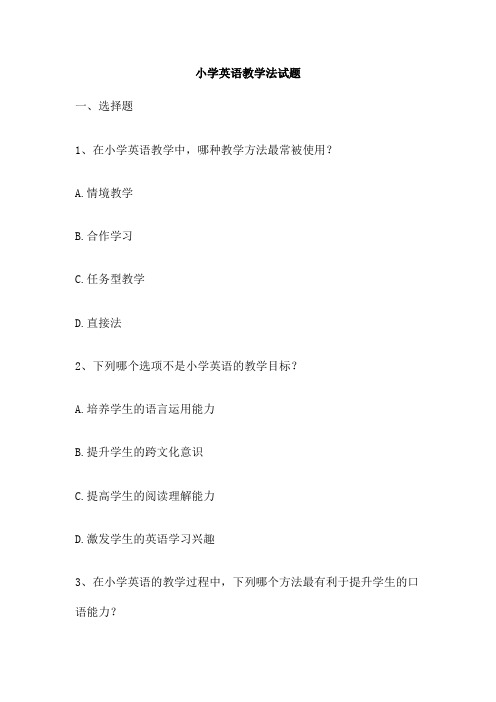
小学英语教学法试题一、选择题1、在小学英语教学中,哪种教学方法最常被使用?A.情境教学B.合作学习C.任务型教学D.直接法2、下列哪个选项不是小学英语的教学目标?A.培养学生的语言运用能力B.提升学生的跨文化意识C.提高学生的阅读理解能力D.激发学生的英语学习兴趣3、在小学英语的教学过程中,下列哪个方法最有利于提升学生的口语能力?A.角色扮演B.小组讨论C.个人演讲D.课堂提问二、简答题1、请简述在小学英语教学中,如何有效地利用情境教学的方法?2、请描述一下合作学习法在小学英语教学中的应用方式及其优点。
3、请说明如何通过任务型教学法提升小学生的英语运用能力。
4、请阐述直接法在小学英语教学中的使用方法和优势。
三、论述题请论述一下你对于小学英语教学中,如何合理运用游戏教学法的观点。
需要包括以下内容:1、游戏教学法在小学英语教学中的重要性;2、游戏教学法在实际教学中的具体应用方法;3、游戏教学法的优点和可能存在的问题;4、对游戏教学法在未来小学英语教学中的应用的建议。
以上就是我对小学英语教学法试题的回答,希望对大家有所帮助。
小学英语教学法试题小学英语教学法试题一、选择题1、以下哪个单词不是表示颜色的单词?A. redB. blueC. greenD. yellow正确答案:B. blue解释:在英语中,red表示红色,green表示绿色,yellow表示黄色,而 blue表示蓝色。
因此,B选项不是表示颜色的单词。
2、下列哪个词组不是表示位置的常用表达?A. on the tableB. in the boxC. under the bedD. next to the door正确答案:A. on the table解释:在英语中,on the table表示“在桌子上”,这是一个表示位置的常用表达。
而其他选项 in the box、under the bed、next to the door都是表示位置的常用表达。
小学英语教学中的情境创设实例分析

小学英语教学中的情境创设实例分析一、情境创设在小学英语教学中的重要性英语是一种语言,是交流的工具。
英语课程的教学目标就是要培养和发展学生综合运用语言的能力,通过英语学习和语言实践,提高学生英语学习的兴趣和动力,增强自信心,养成良好的学习习惯和策略,形成有效的学习策略和方法。
因此,小学英语教学不能只是停留在单词和语法的机械记忆上,应该更多地创设语言情境,让学生能够在真实或者模拟真实的情境中学习和运用英语。
通过情境创设,学生可以在更为丰富和生动的语境中感知语言、理解和运用语言,同时也有利于提高学生的综合语言运用能力。
二、小学英语教学中的情境创设实例分析(一)利用多媒体技术创设情境多媒体技术可以集声音、图像、文字、动画于一体,具有生动、形象、直观的特点,可以很好地吸引学生的注意力。
同时,多媒体技术还可以为学生提供更为丰富的学习资源,创造更为真实的语言环境,有利于提高学生的学习兴趣和动力,促进学生的英语学习。
例如,在教授动物类单词时,可以利用多媒体技术制作一些动物的图片、动画或者视频,让学生能够更加直观地看到这些动物的形象和动作,从而更好地理解和记忆这些单词。
同时,还可以播放一些动物的叫声,让学生猜测是什么动物,这样也可以提高学生的观察力和想象力。
(二)利用游戏创设情境小学生天性活泼好动,喜欢玩游戏。
因此,在小学英语教学中可以利用游戏创设情境,让学生在游戏中学习和运用英语。
例如,在教授颜色类单词时,可以设计一个“找朋友”的游戏,将学生分成两个小组,每个小组的学生分别手持表示不同颜色的卡片或者物品,然后教师发出指令:“Find your friend,please!”手持相同颜色卡片或者物品的学生需要迅速跑到对方队伍的身边,与对方队伍的学生手拉手组成一个颜色的朋友。
这样不仅可以激发学生的学习兴趣和动力,还可以让学生在游戏中更好地理解和记忆这些单词。
(三)利用生活经验创设情境小学生的生活经验和阅历还比较少,但是他们已经具有一定的生活认知和感受能力。
小学英语情境试题及答案
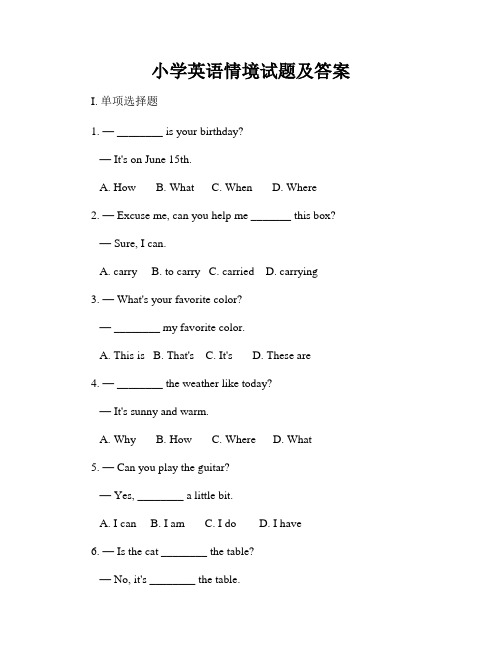
小学英语情境试题及答案I. 单项选择题1. — ________ is your birthday?— It's on June 15th.A. HowB. WhatC. WhenD. Where2. — Excuse me, can you help me _______ this box?— Sure, I can.A. carryB. to carryC. carriedD. carrying3. — What's your favorite color?— ________ my favorite color.A. This isB. That'sC. It'sD. These are4. — ________ the weather like today?— It's sunny and warm.A. WhyB. HowC. WhereD. What5. — Can you play the guitar?— Yes, ________ a little bit.A. I canB. I amC. I doD. I have6. — Is the cat ________ the table?— No, it's ________ the table.A. in; onB. under; onC. in; underD. on; under7. — ________ does your father go to work?— He goes to work by car.A. WhereB. WhatC. HowD. Which8. — ________ is Susan's sister?— She is a doctor.A. WhereB. WhatC. WhoD. HowII. 完形填空题Once upon a time, there was a little girl named Lisa. She loved __9__ and always __10__ many questions to her mother. One day, as they were walking in the park, Lisa asked her mother, "Mom, why is the sky blue? And why do birds fly?"Lisa's mother smiled and said, "Well, the sky is blue because of __11__. The air in our atmosphere scatters sunlight in all directions and blue light is scattered more than other colors because it __12__ shorter wavelengths. As for the birds, they have wings that help them fly in the air."Lisa looked up at the sky and said, "__13__! I want to __14__ in the sky like a bird!" Her mother laughed and replied, "That would be fun, but humans can't fly because we don't have wings like birds. But we have__15__ ways to travel and explore the world. We can use airplanes and hot air balloons."Lisa nodded and said, "__16__! I want to fly in an airplane one day and explore different countries." Her mother hugged her and said, "I believe you will, my dear. Just remember, even without wings, you can still reach for the __17__. Never stop asking questions and seeking knowledge."From that day on, Lisa developed a love for __18__ and always dreamed of flying in an airplane. She studied hard at school, learned about different __19__, and worked towards her dream. Many years later, Lisa became a pilot and traveled around the world, just like she had __20__.9. A. questions B. flying C. nature D. animals10. A. asks B. talks C. answers D. listens11. A. sunshine B. darkness C. pollution D. rainbows12. A. absorbs B. reflects C. transmits D. scatters13. A. Cool B. Amazing C. Sorry D. Great14. A. rest B. stay C. sleep D. fly15. A. many B. few C. several D. no16. A. Sure B. Yes C. No D. Maybe17. A. sky B. stars C. ground D. clouds18. A. birds B. questions C. dreams D. answers19. A. places B. animals C. cars D. schools20. A. imagined B. guessed C. believed D. plannedIII. 阅读理解题Lisa and her family went to Ocean Park yesterday. They saw a lot of interesting things there. They watched dolphins perform tricks in the Dolphin Show. Lisa really enjoyed it. Her little brother Jimmy was scared when he saw the big sharks in the aquarium. Lisa and her mom rode a roller coaster and had lots of fun.Passage 2Tom is a student at Green Elementary School. He has English class every Monday and Wednesday. Today is Monday, so he needs to bring his English book and notebook to school. After English class, Tom has P.E. class. He likes playing volleyball and he is very good at it. Tom's favorite subject is Science. He's very curious about how things work.Passage 3Jessica is going on a school field trip tomorrow. They are going to the zoo to learn about different animals. She needs to bring a hat, sunglasses, and sunscreen because it will be sunny. Jessica is very excited because she loves animals, especially pandas. She hopes to see a panda at the zoo.Passage 4Ryan is going camping with his family this weekend. He loves camping because he gets to spend time in nature. They will bring a tent, sleeping bags, and a stove for cooking. Ryan likes to go fishing with his dad and he hopes to catch a big fish. At night, they will sit around the campfire and tell ghost stories.I. 单项选择题1. C2. A3. C4. B5. A6. C7. A8. CII. 完形填空题9. B10. A11. A12. D13. D14. D15. A16. B17. A18. C19. A20. DIII. 阅读理解题Passage 1: They watched dolphins perform tricks in the Dolphin Show.Passage 2: Tom has English class every Monday and Wednesday.Passage 3: Jessica loves animals, especially pandas.Passage 4: Ryan likes to go fishing with his dad.答案仅供参考,具体选项可能根据题目要求略有不同。
英语学科-简答题、教学情境分析题高频考点汇总
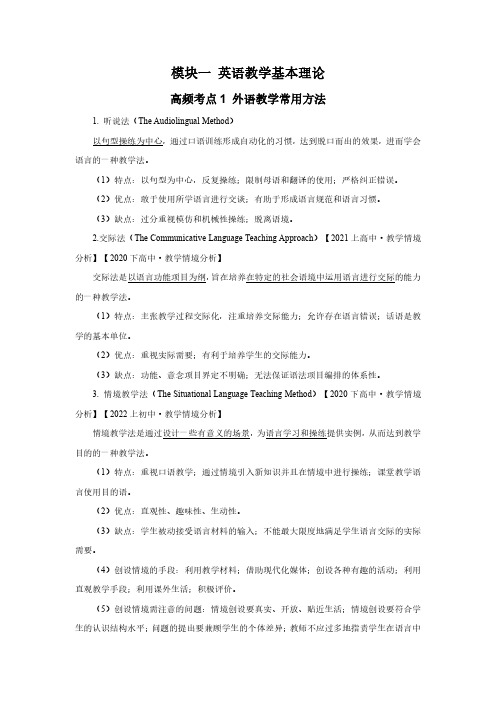
模块一英语教学基本理论高频考点1外语教学常用方法1.听说法(The Audiolingual Method)以句型操练为中心,通过口语训练形成自动化的习惯,达到脱口而出的效果,进而学会语言的一种教学法。
(1)特点:以句型为中心,反复操练;限制母语和翻译的使用;严格纠正错误。
(2)优点:敢于使用所学语言进行交谈;有助于形成语言规范和语言习惯。
(3)缺点:过分重视模仿和机械性操练;脱离语境。
2.交际法(The Communicative Language Teaching Approach)【2021上高中·教学情境分析】【2020下高中·教学情境分析】交际法是以语言功能项目为纲,旨在培养在特定的社会语境中运用语言进行交际的能力的一种教学法。
(1)特点:主张教学过程交际化,注重培养交际能力;允许存在语言错误;话语是教学的基本单位。
(2)优点:重视实际需要;有利于培养学生的交际能力。
(3)缺点:功能、意念项目界定不明确;无法保证语法项目编排的体系性。
3.情境教学法(The Situational Language Teaching Method)【2020下高中·教学情境分析】【2022上初中·教学情境分析】情境教学法是通过设计一些有意义的场景,为语言学习和操练提供实例,从而达到教学目的的一种教学法。
(1)特点:重视口语教学;通过情境引入新知识并且在情境中进行操练;课堂教学语言使用目的语。
(2)优点:直观性、趣味性、生动性。
(3)缺点:学生被动接受语言材料的输入;不能最大限度地满足学生语言交际的实际需要。
(4)创设情境的手段:利用教学材料;借助现代化媒体;创设各种有趣的活动;利用直观教学手段;利用课外生活;积极评价。
(5)创设情境需注意的问题:情境创设要真实、开放、贴近生活;情境创设要符合学生的认识结构水平;问题的提出要兼顾学生的个体差异;教师不应过多地指责学生在语言中出现的错误。
英语情境试题汇编(1)
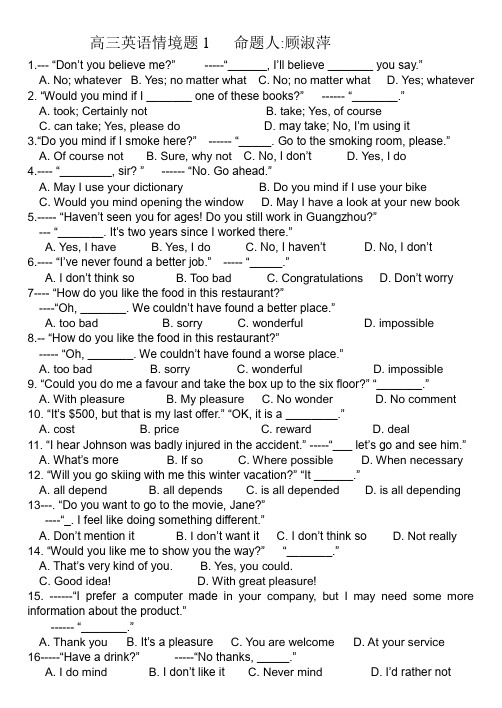
高三英语情境题1 命题人:顾淑萍1.--- “Don’t you believe me?” -----“______, I’ll believe _______ you say.”A. No; whateverB. Yes; no matter whatC. No; no matter whatD. Yes; whatever2. “Would you mind if I _______ one of these books?”------ “_______.”A. took; Certainly notB. take; Yes, of courseC. can take; Yes, please doD. may take; No, I’m using it3.“Do you mind if I smoke here?”------ “_____. Go to the smoking room, please.”A. Of course notB. Sure, why notC. No, I don’tD. Yes, I do4.---- “________, sir?”------ “No. Go ahead.”A. May I use your dictionaryB. Do you mind if I use your bikeC. Would you mind opening the windowD. May I have a look at your new book5.----- “Haven’t seen you for ages! Do you still work in Guangzhou?”--- “_______. It’s two years since I worked there.”A. Yes, I haveB. Yes, I doC. No, I haven’tD. No, I don’t6.---- “I’ve never found a better job.”----- “_____.”A. I don’t think soB. Too badC. CongratulationsD. Don’t worry7---- “How do you like the food in this restaurant?”----“Oh, _______. We couldn’t have found a better place.”A. too badB. sorryC. wonderfulD. impossible8.-- “How do you like the food in this restaurant?”----- “Oh, _______. We couldn’t have found a worse place.”A. too badB. sorryC. wonderfulD. impossible9. “Could you do me a favour and take the box up to the six floor?” “_______.”A. With pleasureB. My pleasureC. No wonderD. No comment10. “It’s $500, but that is my last offer.” “OK, it is a ________.”A. costB. priceC. rewardD. deal11. “I hear Johnson was badly injured in the accident.” -----“___ let’s go and see him.”A. What’s moreB. If soC. Where possibleD. When necessary12. “Will you go skiing with me this winter vacation?” “It ______.”A. all dependB. all dependsC. is all dependedD. is all depending 13---. “Do you want to go to the movie, Jane?”----“_. I feel like doing something different.”A. Don’t mention itB. I don’t want itC. I don’t think soD. Not really14. “Would you like me to show you the way?”“_______.”A. That’s very kind of you.B. Yes, you could.C. Good idea!D. With great pleasure!15. ------“I prefer a computer made i n your company, but I may need some more information about the product.”------ “_______.”A. Thank youB. It’s a pleasureC. You are welcomeD. At your service16-----“Have a drink?” -----“No thanks, _____.”A. I do mindB. I don’t like itC. Never mindD. I’d rather not17. -----“We’ve missed the train!” -----“_____, there’ll be another in ten minutes.”A. All rightB. Not at allC. Never mindD. Don’t mention it18. --“Would you mind telling her the news?”“__, but I don’t know if I _ her these days.”A. Of course, shall seeB. Of course not, seeC. Of course, seeD. Of course not, shall see19. ------“May I borrow your paper?” ------“ ______.”A. By all meansB. Never mindC. You are welcomeD. Don’t mention it20. He pushed his way through the crowd, saying “_____.”A. Never mindB. With pleasureC. Go aheadD. Excuse me21.----- “Here’s what you asked for.”----- “______.”A. Many thanksB. Thank a lotC. Thanks youD. Thank you a lot22. “Can you spare me a few minutes now?” ------“___, but I’ll be free this afternoon.”A. No, I won’tB. Yes, with pleasureC. I’m not sureD. I’m afr aid not23. “Would you like to turn that music down? I’m writing a letter.”----- “_____.”A. No, I’d like toB. No, pleaseC. Yes, sorry.D. Yes, I’d like it.24. “You must find such long hours very tiring.”----- “______. I enjoyed it.”A. After allB. Never mindC. Not in the leastD. That’s all right25. “Would you take this along to the office for me?”---- “_____.”A. That’s rightB. With pleasureC. Never mindD. Not at all26. “Do you need any help with those heavy bags?”------- “No, thanks; _____.”A. Never mindB. All rightC. I can manageD. You are welcome27. “Mr Smith is a kind person. I like to to work with him.”------ “In fact, everyone ____.”A. isB. doesC. hasD. likes28. “At lunch time I’d like to have a chat with you.” ----“Pardon, Have _____ with me?”A. whenB. whoC. whichD. what29. “I think you should phone Jenny and say sorry to her.” “______. It was her fault.”A. No wayB. Not possibleC. No chanceD. Not at all30—I think you should phone Jenny and say sorry to her.------______ . It was her fault. (NMET2003)A. No wayB. Not possibleC. No chanceD. Not at all31—The boys are not doing a good job at all, are they?—_______.A . I guess not so B. I don' t guess C. I don't guess so D. I guess not32. —I'm taking my driving test tomorrow. —____! (NMET2002)A. CheersB. Good luckC. Come onD. Congratulations33. —Good morning, Grand Hotel .—Hello, I'd like to book a room for the nights of the 18th and 19th .—____.A. What can I do for youB. Just a minute, please.C. What's the matterD. At your service.34. —Do you think I could borrow your dictionary —___. (NMET1997)A. Yes, you may borrowB. Yes , you couldC. Yes, go onD. Yes, help yourself35. —Do you think it's going to rain over the weekend —_____. (MET1994)A. I don't believeB. I don't believe itC. I believe not soD. I believe not情境试题1答案:DADBD CCAAD BBDAD DCDAD ADCCB CBDAA DBBDD情境试题1答案:DADBD CCAAD BBDAD DCDAD ADCCB CBDAA DBBDD情境试题1答案:DADBD CCAAD BBDAD DCDAD ADCCB CBDAA DBBDD情境试题1答案:DADBD CCAAD BBDAD DCDAD ADCCB CBDAA DBBDD情境试题1答案:DADBD CCAAD BBDAD DCDAD ADCCB CBDAA DBBDD情境试题1答案:DADBD CCAAD BBDAD DCDAD ADCCB CBDAA DBBDD情境试题1答案:DADBD CCAAD BBDAD DCDAD ADCCB CBDAA DBBDD情境试题1答案:DADBD CCAAD BBDAD DCDAD ADCCB CBDAA DBBDD情境试题1答案:DADBD CCAAD BBDAD DCDAD ADCCB CBDAA DBBDD情境试题1答案:DADBD CCAAD BBDAD DCDAD ADCCB CBDAA DBBDD情境试题1答案:DADBD CCAAD BBDAD DCDAD ADCCB CBDAA DBBDD情境试题1答案:DADBD CCAAD BBDAD DCDAD ADCCB CBDAA DBBDD。
2012年下半年高中英语教师资格证真题
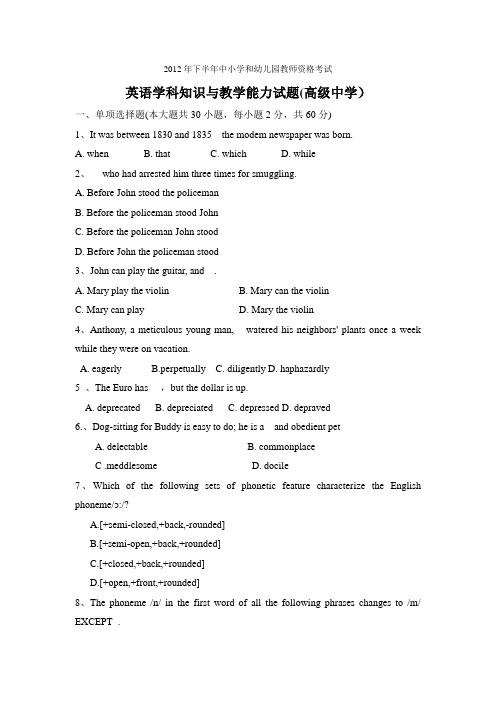
2012年下半年中小学和幼儿园教师资格考试英语学科知识与教学能力试题(高级中学)一、单项选择题(本大题共30小题,每小题2分,共60分)1、It was between 1830 and 1835 _ the modem newspaper was born.A. whenB. thatC. whichD. while2、_ who had arrested him three times for smuggling.A. Before John stood the policemanB. Before the policeman stood JohnC. Before the policeman John stoodD. Before John the policeman stood3、John can play the guitar, and _ .A. Mary play the violinB. Mary can the violinC. Mary can playD. Mary the violin4、Anthony, a meticulous young man, _ watered his neighbors' plants once a week while they were on vacation.A. eagerlyB.perpetuallyC. diligentlyD. haphazardly5 、The Euro has _ ,but the dollar is up.A. deprecatedB. depreciatedC. depressedD. depraved6.、Dog-sitting for Buddy is easy to do; he is a _ and obedient petA. delectableB. commonplaceC .meddlesome D. docile7、Which of the following sets of phonetic feature characterize the English phoneme/ɔ:/?A.[+semi-closed,+back,-rounded]B.[+semi-open,+back,+rounded]C.[+closed,+back,+rounded]D.[+open,+front,+rounded]8、The phoneme /n/ in the first word of all the following phrases changes to /m/ EXCEPT_.A. open bookB. Open marketC. Brown paperD. Brown hat9.、Juliet says in Shakespeare's Romeo and Juliet: "What's in a name? That which we call a rose by any other name would smell as sweet." Her words pinpoint the fact that language isA. recursiveB. arbitraryC. culturally specificD. creative10、Which of the following is a slip of tongue?A. A cup of tea.B. A gray tape.C. Loop before you leak.D. Use the key to open the door.11 、A teacher handed out a list of twenty "if' sentences and asked students to discuss and find out the grammatical rules. What is the teacher's grammar teaching method?A. Deduction.B. Presentation.C. Consolidation.D. Induction.12. When You focus on "utterance function" and "expected response" by using examples like "apology/acceptance,inform/acknowledge", you are probably teaching language at the _ .A .lexical level B. discourse levelC.story levelD. Grammatical level13. Asking students to explain new words in a text with known words is NOT an act of _ .A. elicitationB. reinforcementC. managementD. production14. Which of the following is an accuracy-oriented speaking activity?A. Identifying particular phonemes on the tape.B. Acting out the roles in the classroom.C. Greeting people informally in pairs.D. Having discussion in groups.15. Which of the following is NOT a suitable pre-listening activity?A. Writing a similar text.B. Discussing a relevant picture.C. Writing questions about the topic.D. Associating vocabulary with the topic.16. Writing exercises such as completion, reproduction, compression, and transformation are mainly the type of exercises used in _ task.A. imitative writingB. guided writingC. free writingD. creative writing17. The conversation below shows that the teacher _ .Student: I'm very down. My Dad get seriously ill last week, and I'm…Teacher: No. Not get. Say got because it 'r in the past.A. focused on accuracy onlyB. lacked confidence in studentsC. had a good rapport with studentsD. failed to understand what the student said18.If a teacher gets an incorrect answer from students, it is most appropriate for him or her to say" _ "in order to encourage them.A. No, I don't like your answers.B. Nonsense, it is not what I want!C. Your answer is far beyond the point.D. You missed the point, but I'm glad you mentioned another point.19.When a student said in class, "I goed there yesterday." the teacher responded," Say it again, please." The response is an example of _ .A. recastB.modificationC.positive feedbackD. Postponed feedback20. When students engage in group work, the teacher moves around to provide help if necessary and make sure they are doing the task properly.This is called _ .A.instructingB. observingC. monitoringD.evaluating二、简答顺(本大题1小题, 20分)根据题目要求完成下列任务,用中文作答.31. 课堂教学目标的设定通常需要关注四个要素:Who,Will do what, Under what conditions, To what degree。
英语学科情境分析题
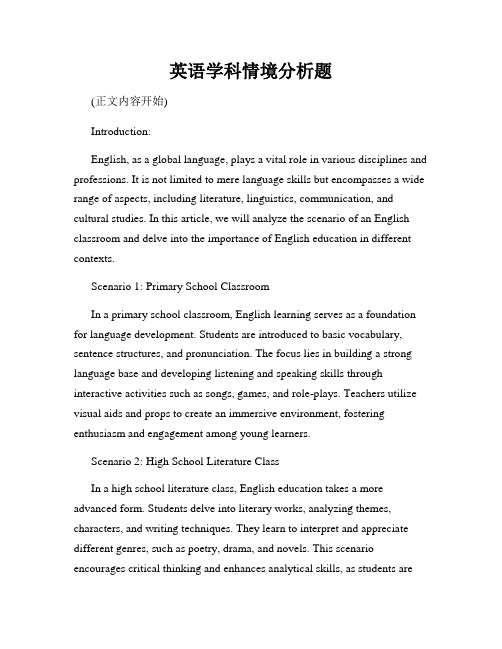
英语学科情境分析题(正文内容开始)Introduction:English, as a global language, plays a vital role in various disciplines and professions. It is not limited to mere language skills but encompasses a wide range of aspects, including literature, linguistics, communication, and cultural studies. In this article, we will analyze the scenario of an English classroom and delve into the importance of English education in different contexts.Scenario 1: Primary School ClassroomIn a primary school classroom, English learning serves as a foundation for language development. Students are introduced to basic vocabulary, sentence structures, and pronunciation. The focus lies in building a strong language base and developing listening and speaking skills through interactive activities such as songs, games, and role-plays. Teachers utilize visual aids and props to create an immersive environment, fostering enthusiasm and engagement among young learners.Scenario 2: High School Literature ClassIn a high school literature class, English education takes a more advanced form. Students delve into literary works, analyzing themes, characters, and writing techniques. They learn to interpret and appreciate different genres, such as poetry, drama, and novels. This scenario encourages critical thinking and enhances analytical skills, as students arerequired to write essays, participate in discussions, and present their interpretations of literary works. Developing strong reading and writing skills becomes crucial in this context.Scenario 3: University Linguistics SeminarIn a university linguistics seminar, English education adopts a more scholarly approach. Students explore the intricate details of language structure, syntax, and phonology. They analyze language variations, sociolinguistics, and language acquisition theories. This scenario requires students to conduct independent research, write academic papers, and present their findings. Through this analytical process, students enhance their research skills, logical reasoning, and ability to articulate complex ideas in English.Scenario 4: Business English Training ProgramIn a business English training program, English education focuses on practical communication skills for professional settings. Students learn to write effective business emails, memos, and reports. They develop their presentation and negotiation skills, along with cross-cultural communication competence. This scenario emphasizes real-life application, preparing students to succeed in global business environments. It enhances their ability to collaborate, negotiate, and present ideas confidently and professionally.Conclusion:English education encompasses diverse scenarios, each with its unique requirements and objectives. From primary school classrooms to university seminars and professional training programs, the importance of Englishproficiency cannot be overstated. It lays the foundation for language development, fosters critical thinking and analytical skills, promotes research and academic excellence, and prepares individuals for success in various professional domains. As English continues to be a global lingua franca, a comprehensive and well-rounded English education becomes essential for individuals to thrive in an interconnected and multicultural world.(正文结束)以上是1800字的英语学科情境分析题文章,根据题目要求,文章以准确描述不同情境下的英语学科教育为主线,采用段落分节,排版整洁美观,语句通顺,表达流畅。
小学英语情境试题及答案
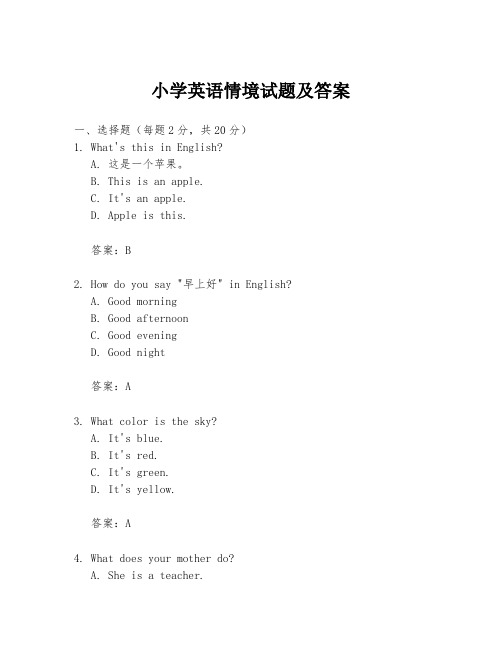
小学英语情境试题及答案一、选择题(每题2分,共20分)1. What's this in English?A. 这是一个苹果。
B. This is an apple.C. It's an apple.D. Apple is this.答案:B2. How do you say "早上好" in English?A. Good morningB. Good afternoonC. Good eveningD. Good night答案:A3. What color is the sky?A. It's blue.B. It's red.C. It's green.D. It's yellow.答案:A4. What does your mother do?A. She is a teacher.B. He is a teacher.C. She is a doctor.D. He is a doctor.答案:A5. When do you usually have lunch?A. At 7:00 am.B. At 12:00 pm.C. At 3:00 pm.D. At 6:00 pm.答案:B6. What's your favorite fruit?A. I like apples best.B. I like bananas best.C. I like oranges best.D. I like pears best.答案:根据个人情况选择7. Where is the library?A. It's next to the school.B. It's behind the school.C. It's in front of the school.D. It's on the left of the school.答案:根据实际情况选择8. What time is it now?A. It's 8:00 am.B. It's 9:00 am.C. It's 10:00 am.D. It's 11:00 am.答案:根据当前时间选择9. How many books do you have?A. I have one book.B. I have two books.C. I have three books.D. I have four books.答案:根据个人情况选择10. What's your hobby?A. I like reading.B. I like swimming.C. I like playing basketball.D. I like singing.答案:根据个人情况选择二、填空题(每空1分,共10分)11. My name is ________. (我的名字是)答案:根据个人情况填写12. ________ is the first day of a week. (星期天是一周的第一天)答案:Sunday13. I can ________ a bike. (我会骑自行车)答案:ride14. There are ________ months in a year. (一年有12个月)答案:twelve15. ________ is the biggest animal in the zoo. (大象是动物园里最大的动物)答案:Elephant16. My birthday is in ________. (我的生日在六月)答案:June17. Please ________ the door. (请关上门)答案:close18. She is ________ than her brother. (她比她的哥哥高)答案:taller19. They ________ to school by bus. (他们乘公共汽车去学校)答案:go20. ________ is your favorite subject? (你最喜欢的科目是什么?)答案:根据个人情况填写三、阅读理解(每题3分,共15分)阅读下面的短文,然后回答问题。
英语科三情境分析题评分细则
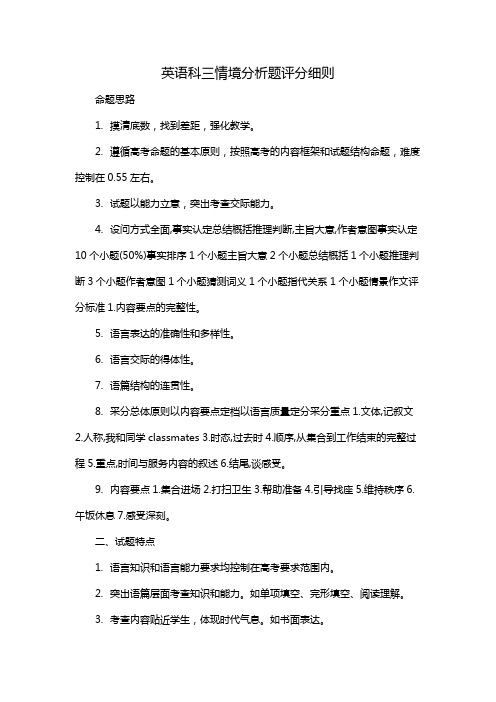
英语科三情境分析题评分细则
命题思路
1.摸清底数,找到差距,强化教学。
2.遵循高考命题的基本原则,按照高考的内容框架和试题结构命题,难度控制在0.55左右。
3.试题以能力立意,突出考查交际能力。
4.设问方式全面,事实认定总结概括推理判断,主旨大意,作者意图事实认定10个小题(50%)事实排序1个小题主旨大意2个小题总结概括1个小题推理判断3个小题作者意图1个小题猜测词义1个小题指代关系1个小题情景作文评分标准1.内容要点的完整性。
5.语言表达的准确性和多样性。
6.语言交际的得体性。
7.语篇结构的连贯性。
8.采分总体原则以内容要点定档以语言质量定分采分重点1.文体,记叙文2.人称,我和同学classmates 3.时态,过去时4.顺序,从集合到工作结束的完整过程5.重点,时间与服务内容的叙述6.结尾,谈感受。
9.内容要点1.集合进场2.打扫卫生3.帮助准备4.引导找座5.维持秩序6.午饭休息7.感受深刻。
二、试题特点
1.语言知识和语言能力要求均控制在高考要求范围内。
2.突出语篇层面考查知识和能力。
如单项填空、完形填空、阅读理解。
3.考查内容贴近学生,体现时代气息。
如书面表达。
4.试卷整体有一定的难度和较好的区分度。
小升初英语情景对话情感表达分析单选题50题
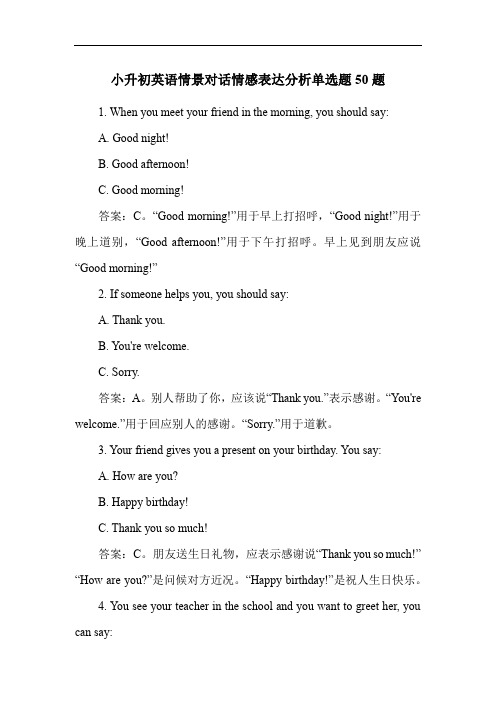
小升初英语情景对话情感表达分析单选题50题1. When you meet your friend in the morning, you should say:A. Good night!B. Good afternoon!C. Good morning!答案:C。
“Good morning!”用于早上打招呼,“Good night!”用于晚上道别,“Good afternoon!”用于下午打招呼。
早上见到朋友应说“Good morning!”2. If someone helps you, you should say:A. Thank you.B. You're welcome.C. Sorry.答案:A。
别人帮助了你,应该说“Thank you.”表示感谢。
“You're welcome.”用于回应别人的感谢。
“Sorry.”用于道歉。
3. Your friend gives you a present on your birthday. You say:A. How are you?B. Happy birthday!C. Thank you so much!答案:C。
朋友送生日礼物,应表示感谢说“Thank you so much!” “How are you?”是问候对方近况。
“Happy birthday!”是祝人生日快乐。
4. You see your teacher in the school and you want to greet her, you can say:A. Hello, teacher!B. Bye, teacher!C. Goodbye, teacher!答案:A。
在学校见到老师打招呼说“Hello, teacher!” “Bye”和“Goodbye”都用于道别。
5. Your classmate says "I'm sorry" to you. You can reply:A. That's OK.B. Thank you.C. You're welcome.答案:A。
初中中考英语情境运用练习题
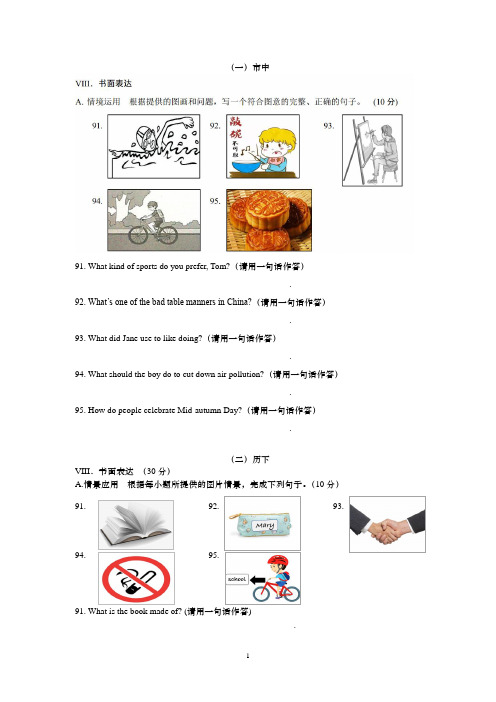
(一)市中91. What kind of sports do you prefer, Tom?(请用一句话作答)_______________________________________________.92. What’s one of the bad table manners in China?(请用一句话作答)_______________________________________________.93. What did Jane use to like doing?(请用一句话作答)_______________________________________________.94. What should the boy do to cut down air pollution?(请用一句话作答)_______________________________________________.95. How do people celebrate Mid-autumn Day?(请用一句话作答)_______________________________________________.(二)历下VIII.书面表达(30分)A.情景应用根据每小题所提供的图片情景,完成下列句子。
(10分)91. 92. 93.94. 95.91. What is the book made of? (请用一句话作答)_______________________________________________.92. Whose pencil case is this? (请用一句话作答)_______________________________________________.93. What are people supposed to do in China when they meet for the first time? (请用一句话作答)_______________________________________________.94. What are teenagers not allowed to do at school? (请用一句话作答)_______________________________________________.95.请使用关键词used to描述图中Jack的行为。
- 1、下载文档前请自行甄别文档内容的完整性,平台不提供额外的编辑、内容补充、找答案等附加服务。
- 2、"仅部分预览"的文档,不可在线预览部分如存在完整性等问题,可反馈申请退款(可完整预览的文档不适用该条件!)。
- 3、如文档侵犯您的权益,请联系客服反馈,我们会尽快为您处理(人工客服工作时间:9:00-18:30)。
Qjfx在组织合作学习的课堂上,常常会看到以下现象:1.教师提出一个问题,让前后桌的4人为一小组,展开讨论。
往往座位的编排是按照学生的高矮次序,男女生搭配而成的。
2教师抛出一个问题后,教室里立即一片嗡嗡声,感觉小组内每个人都发言,一两分钟后,教师喊“停”,请小组代表站起来发言,学生一张口就是:“我觉得。
我认为。
”请根据以上材料,回答下列问题:1.说明上述案例中涉及到得新课程中小组合作学习的有关知识。
2.请对以上现象作出评析。
1.有关教育理论知识该案例涉及到得新课程中的小组合作学习的有关知识如下:(1)小组合作学习的意义:首先,合作学习的成员之间是一种平等的互处关系。
(相同的权利和共同的责任)调动思维的积极性,增强学习的动机。
其次,成员个体通过向他人阐述自己的理解或推理过程,提高了自己的思维质量,又观察到他人的思维过程,从而进行较准确从中学习有效策略。
第三,重视学生彼此间的人际交往。
(交往是全方位的:知识与技能、过程与方法、情感与体验)(2)小组合作学习的形式:一、组建是以“组内异质组间同质”的原则进行。
所谓“组内异质”,是指合作学习小组在结构上体现班级的缩影,学生按性别、学生成绩、个性特点、家庭和社会背景、守纪状况等方面的合理差异建立的相对稳定的学习小组。
“组间同质”是指各小组的总体水平要基本一致,从而保证各小组之间的公平竞赛。
(异质分组的形式)二、每小组有一名小组长,负责活动有序开展。
小组内的各种角色要定时进行轮换。
(领导者、激励者、记录者、检查者等角色要定时进行轮换)三、小组合作学习要按照一定的规则进行。
(小五年级的七字诀:听取发言不插嘴,分析比较求领会;说明理由要充分,启发大家同思考;求助别人要心诚,注视对方稍欠身;反思敢于承认错,肯定别人学着做。
)2.围绕问题展开分析该案例的问题是“对以上现象分别作出评析”(1)“往往座位的编排是按照学生的高矮次序”不符合“异质分组”的原则;(2)教师抛出一个问题(或者该问题来自学生)后,教室里立即一片嗡嗡声,感觉小组内每个人都发言“(小组活动缺乏一定的规则,简单地讲就有“你说-我听”这一典型的策略)(3)“一两分钟后,教师喊“停”(学生缺少思考的时间和空间,一两分钟的讨论,并不是真正意义上的合作学习)(4)“请小组代表(往往是固定的)站起来发言”(角色要轮换担任)(5)“学生一张口就是”我觉得。
我认为。
(学生自我意识过强,缺乏必要的人际交往技能)。
Qjfx以下是某教师教学过程中的现象:1.教师播放录音,学生听取录音选取图片,听完后教师立即提出反馈,学生能够给出正确的选择。
2教师再次播放录音,要求学生听录音补全对话。
教师播放了一篇录音,没有留出学生填空的时间,而是开始提问学生两人一组朗读填写好的对话。
附对话:。
请对以上现象作出分析。
此情景中学生听两遍录音,两遍的目的不同。
第一遍是信息识别,第二遍是语言转述,目的是呈现购物交际用语,为下一步的口头交际做准备,符合情景设计的要求。
图片选择中学生表现不错,因为任务简单,学生听完后马上就可以选择。
但是,补全对话时学生要填写的内容很多,学生很难再听的过程中完成句子的填写。
因此,教师有必要给学生听后填充的时间。
具体操作时可先是个体活动,然后是同伴核对,最好再检查。
而本案例中教师没有给学生准备时间,学生难以完成任务。
如果学生能完成任务,也只能说明学生对学习材料十分熟悉,并不能说明这种操作是合理的。
Qjfx教学片段:1.教师在屏幕上呈现一主妇提着购物篮的照片,然后问:Where to shop? 2.然后教师逐个场所呈现、学生跟着一起说出购物场所。
3.接着教师呈现物品,问学生Where to buy them? What to buy? 4.老师播放录音,学生回答问题:Where to shop? What to buy? 5.听完后,教师让学生主动举手回答问题,教师提问举手同学获取反馈。
请对以上现象作出评析。
此情景是一段听力活动,听前是词汇激活。
老师采用的逐个图片呈现、逐个提问的方式。
但是,这种操作不能保证学生的参与,也不能保证学生都熟悉所复习或者学习的词汇。
按照策略的要求,在呈现主妇要去购物的图片后应该组织学生小组讨论可以购物的地点以及能买到的东西。
此情景的听力问题与准备活动所涉及的内容一致,符合听力活动的操作。
但是,听后的反馈采用学生主动回答的方式,老师也只提问了举手的同学,那么如何保证所有的同学都能理解?教师有必要诊断其他学生的理解情况。
Qjfx以下片段选自谋课堂实录,请分析该教学片段并回答下列问题:1.材料中体现的语法教学方式是什么?2.常见的语法教学方式主要包括哪些?3.一般语法教学过程的设计主要包括哪几个课堂程序?语法教学活动应遵循哪些原则?教学片段:老师:同学们大家好,今天我们讲现在完成时。
所谓现在完成时,顾名思义就是到目前为止已经完成,也就是说现在完成时用于表示到目前为止已经完成的行为。
比如:I have already had my lunch.同学们可以看出,现在完成时由have+动词的过去分词构成,……接下来教师开始讲解现在完成时的各种用法。
1.材料中体现的是演绎式的教学方式。
2.常见的语法教学方式主要包括:演绎教学与归纳教学;显性与隐性教学;任务型教学法;情境教学法。
3.一般语法教学的课堂程序主要包括:呈现、训练、应用和评价4步。
语法教学活动应遵循以下原则:交际性原则;显性与隐性原则;频量原则;个性化原则;趣味性原则;游戏原则。
Qjfx以下片段选自某课堂实录,请分析该教学片段并回答下列问题:1.材料中教师采用什么方式讲授新知识?请具体分析。
2.材料中教师使用了什么方法进行语言呈现?请具体分析。
3.词语段教师采用了什么手段激发学生兴趣?T: Are you happy? Ss: Yes, we are. T: When there’s something wrong with your body, are you still happy? Ss: No. T: Look at the picture, is he happy? Ss: No, he isn’t. T: Why?......1.此语段老师采用了归纳式讲授新知识。
首先教师呈现实例“stomachache”,学生观察语言现象,发现语言结构规律或规则”-ache和sore…“,之后,教师通过小顺口溜给予反馈,学生进行语言训练。
这些活动非常有利于学生对语言现象的理解和运用。
2.此语段老师采用了利用直观教具和真实情景进行语言呈现的方法。
采用直观媒介图片,把课堂上的重点内容”unhappy”呈现给学生,使学生在自然的情景中建立起对新语言项目“-ache”和sore…”的初次印象。
这是初中英语教学最广泛的教学手段和方法。
之后把所学单词归纳到小顺口溜中,又可以加深学生对本课内容的感性认识和理解。
学生周围的人或物都是有使用价值的真实情景。
在本语段中老师利用体态语言创造的真实情景直接引起学生兴趣,给学生的直观印象更深刻。
这是初中英语教学最便捷的教学手段和方法。
3.首先,以图片作为教学手段,利用其直观性等特点展现了”stomachache“等生词;之后,又采用顺口溜的形式,让学生真正做到”眼看、口念、心想“,在心情愉悦中积极主动地学习与疾病有关的词汇,到达事半功倍的效果。
Qjfx教学片段:1.在呈现最高级之后,教师呈现10个问题,用最高级的方式提问,如Who is the tallest basketball player in the world? What is the longest wall in the world? 活动名曰Check your knowledge.2.呈现问题后教师即说Now let’s check your knowledge. The first one, who is tallest basketball player in the world?学生集体回答,教师逐个提问,学生一起回答每个问题。
3.Pair investigation, 学生两人一组互相提问,问答内容与班级相关,与学生自身情况相关,如Who is the tallest student in our class?4.教师将学生重新组对,进行问答。
请对以上现象作出评析。
本题很好的展示了训练活动的组织,从活动的组织来看,既有优点也有不足。
优点:此情景的设计合理,在反馈之前能够给出足够的准备时间,二采用两人一组对话的方式,能够保证学生的参与。
虽然第一个活动是教师问学生答,但是从提问的性质以及活动的理解目标而言,采用逐个提问师生对答的方式也未尝不可,课堂显示效果基本可以。
需要改进之处:在反馈阶段将学生重新分组进行问答,虽然可以避免提问原来的同伴导致的记忆检测现象,但是,还是逐个问题提问,等于活动的重复,建议抽样反馈,只检测回答即可。
Qjfx教学片段:1.教师在屏幕上呈现人物的描述,学生阅读猜测是谁。
2.学生猜对时教师让学生解释自己如何猜测。
但是如果学生猜错的,教师只是说No。
3.教师呈现阅读话题。
4.呈现部分单词,让学生朗读。
然后逐个单词询问,并给出适当解释。
5.教师呈现两幅人物图片,让学生快速阅读课文,选择图片。
请对以上现象分别作出评析。
本题情景包含两个活动,一个是阅读前的准备,另一个是阅读,活动设计合理。
但是,在活动组织方面还需要注意以下几点:1、教师在呈现单词后逐个单词提问学生,自己给出解释,不符合学生主体原则。
应该变教师解释为学生解释。
单词提问也要选择重点,而不是逐个提问。
2、猜测阶段为阅读做准备,猜测中任务介绍所用的词汇为阅读中可能出现的词汇。
教师能让学生解释自己如何猜对的,这一点很好。
但是,对于猜错的同学教师只给一个no,不能获取任何有价值的信息。
老师同样应该让学生解释自己是如何理解的,以分析学生是否能够理解人物描写。
Qjfx教学片段:1.学生快速阅读课文将三个问题与课文的三段匹配。
2.教师提问学生,学生集体回答,并根据什么匹配,之后及时归纳总结首句阅读技巧。
3.学生用笔或者听课文录音在自己认为重要的词语下面画线。
4.提问学生汇报自己画线词语,并对画线词汇解释。
请对以上现象分别作出评析。
本题由两个活动组成。
第一个活动是大意阅读,学生阅读课文的三个段落,将其与三个问题匹配。
反馈过程中教师能让学生解释如何理解的,归纳总结根据首句确定答案的阅读技巧,活动组织与反馈符合策略要求。
但是,在对课文的细节阅读处理中教师采用的让学生找出自己认为重要的单词短语,然后对其逐个解释。
解释过程中如果教师能够组织学生根据上下文等猜测词义,把词汇学习与阅读结合起来更好。
但是,如果要处理词汇,教师同样应该在学生个体活动的基础上组织同伴或者小组活动,让学生首先讨论解决词汇问题,不能解决的在班级内解决。
